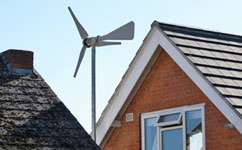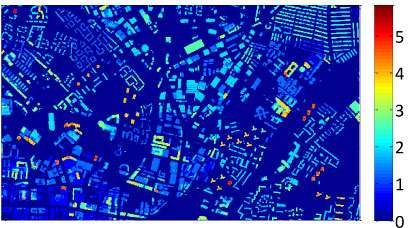Wind map shows untapped energy potential in cities

Putting a wind turbine on your suburban home may leave you disappointed but there is a large untapped wind energy potential in UK cities, say scientists. A new study has mapped the wind energy potential of five city regions, including, Manchester, Edinburgh and Nottingham, to show the best places for small to medium scale wind turbines.
The researchers, from the University of Leeds, hope this will lead to an online tool which tells people how much energy a wind turbine near their home or workplace could produce.
'Our model shows that the best sites for turbines are in the city centre where there's lots of tall buildings less subject to the city's frictional effects. The peripheral regions around the outskirts of a city are also good places,' says PhD student Joel Millward-Hopkins, lead author of the study. 'The lowest capacity seems to be in the suburbs where building heights tend to be lower and more similar to each other.'
The research, published in Renewable Energy, shows that promoting cheap and easy to install small and micro wind turbines on suburban houses may not be the most productive use of wind energy resources. 'People assume the wind turbines they put on their homes will work, but actually these sites are quite poor,' explains Millward-Hopkins.
'Estimating the wind energy available in cities is complicated because of the surface geometry - there are lots of buildings of different heights, and these significantly disrupt the wind flow. Whilst the surface friction may be greater the closer you get to a city centre, there are also more tall buildings which extend above the surface and can access higher winds' explains Professor Alison Tomlin who co-authored the study.
'In the past people have spent money on turbines, and found that on suburban roofs they were not generating as much energy as they expected. We therefore saw the need for more accurate assessment tools predicting wind potential across cities,' she continues.

The model uses digitised data describing building heights and vegetation, to create a 3D map of wind speeds across the city for eight different directions. To build it, the team utilised LiDAR data of building heights, models of how wind behaves near the ground, and MET office data.
The next stage for the team is to develop a low-cost online tool where people type in their postcode and are shown how suitable an area is for a turbine. The team are also working with colleagues to include the information on whether a building is suitable for solar panels.
Instead of promoting small turbines for personal use, the researchers believe we should make better use of the wind potential of tall buildings in city centres and the semi-rural regions at the edges of cities.
'Where you have a 70 metre high building in a city centre the model shows you get very strong wind speeds. You essentially have a 70 metre mast built for you,' explains Millward-Hopkins.
But these buildings are not currently being used as turbines sites. 'You can count on your fingers how many turbines have been installed on tall buildings within Leeds,' says Tomlin. 'It's an untapped resource.'
The researchers think a turbine should be included as standard in plans for tall buildings.
More information: Millward-Hopkins, J. et al. (2013) Mapping the wind resource over UK cities, Renewable Energy, Volume 55, Pages 202-211. dx.doi.org/10.1016/j.renene.2012.12.039
Journal information: Renewable Energy
Provided by PlanetEarth Online
This story is republished courtesy of Planet Earth online, a free, companion website to the award-winning magazine Planet Earth published and funded by the Natural Environment Research Council (NERC).



















